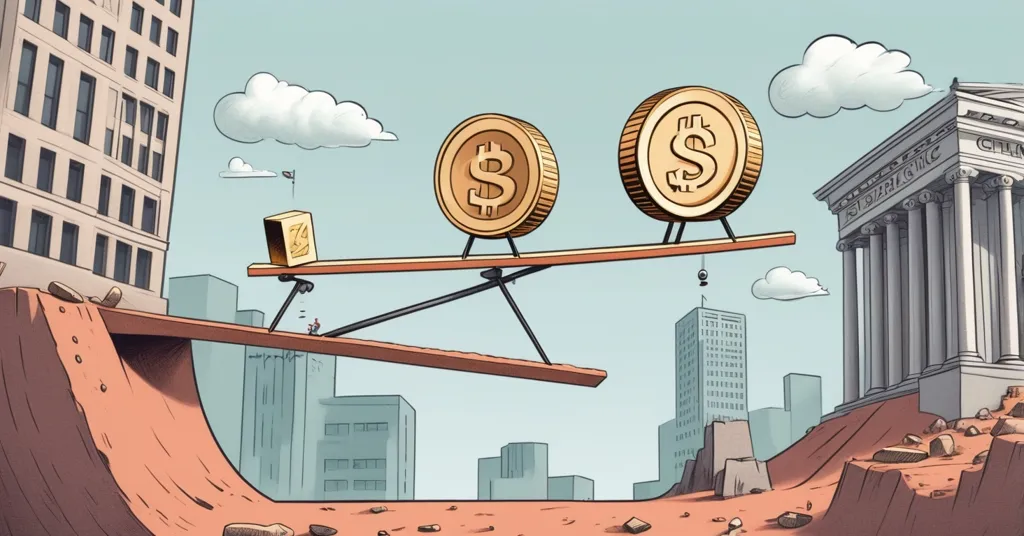Stablecoin Bills in Congress Raise Systemic Bank Run Fears

Systemic Bank Run Risk Looms Over Congressional Stablecoin Bills
The U.S. Congress is currently wrestling with the regulation of stablecoins, digital assets designed to maintain a stable value by pegging to the U.S. dollar. With over $230 billion in stablecoins circulating, the stakes are high as lawmakers push forward bills that could integrate these tokens into the global financial system, raising concerns about potential systemic risks.
- Stablecoins like USDT and USDC could pose systemic risks.
- Congressional bills aim to integrate stablecoins into global payments.
- Critics warn of insufficient safeguards; supporters see U.S. dollar strengthening.
Understanding Stablecoins
Stablecoins are a type of cryptocurrency that aims to offer the benefits of digital currencies, such as fast and borderless transactions, while maintaining a stable value, typically by being pegged to a fiat currency like the U.S. dollar. Imagine if your digital wallet suddenly decided to take a vacation, leaving you with nothing but a pile of worthless tokens. That’s the kind of risk we’re talking about here.
Legislative Landscape
The debate over stablecoin regulation has heated up as two bills make their way through the U.S. House and Senate. President Trump has shown strong support for integrating stablecoins into the financial system, viewing it as a way to bolster the U.S. dollar’s global position. However, not everyone is cheering this move. Senator Elizabeth Warren has been vocal in her criticism, arguing that the proposed legislation lacks the necessary safeguards to prevent financial instability.
On March 13th, the Senate Banking Committee voted 18-6 to move forward with the stablecoin regulation bill, marking a significant step in the legislative process. Yet, the potential for stablecoins to trigger a bank run remains a hot-button issue. Federal Reserve Governor Lisa D. Cook has warned,
“If a run on a large stablecoin were to occur, liquidation of the assets backing the stablecoin could be disruptive, especially if those assets were linked to other funding markets.”
This concern is echoed by the Financial Stability Oversight Council, which has highlighted the risks of stablecoin runs in recent publications.
Expert Perspectives and the Ongoing Debate
Despite these warnings, supporters like Howard Lutnick, Trump’s Secretary of Commerce, and Scott Bessent, the Treasury Secretary, argue that stablecoins could strengthen the U.S. dollar’s status as a global reserve currency. They believe,
“Legitimizing stablecoins helps firm up the U.S. dollar’s dominance as a global reserve currency.”
This perspective is not without its critics, however. Arthur E. Wilmarth Jr., a professor emeritus, has pointed out vulnerabilities in the proposed legislation, particularly the risks posed by short-term U.S. Treasury bills. Nellie Liang, a former Federal Reserve board member, supports amendments to the GENIUS Act, emphasizing the need for stablecoins to hold safe and liquid reserve assets.
Historical Precedents and Real-World Implications
The potential for stablecoins to cause systemic risk is not just theoretical. The 2008 financial crisis serves as a stark reminder of what can happen when financial instruments fail. The Reserve Primary Fund lost its dollar peg due to Lehman Brothers’ debt, causing widespread panic. More recently, the 2023 incident with Silicon Valley Bank, where federal intervention was required to cover depositors, affected USDC’s peg, highlighting the real-world implications of stablecoin stability.
In the midst of this debate, major banks like JP Morgan, Citi, and Charles Schwab are reportedly launching their own stablecoins, according to GC Cooke, CEO of Brava. This move is seen as an attempt to mitigate risks and capitalize on the growing interest in digital assets.
The Balancing Act
As the debate continues, it’s clear that integrating stablecoins into the financial system is a double-edged sword. While they offer the potential to enhance the U.S. dollar’s global reach, the risks of a bank run cannot be ignored. The challenge for Congress is to strike a balance between fostering innovation and ensuring financial stability. While stablecoins hold immense promise for the future of finance, navigating the tightrope between innovation and stability is no easy feat.
At the same time, it’s important to remember that stablecoins, and blockchain technology in general, could enhance decentralization and financial freedom. They align with the principles of “effective accelerationism” (e/acc), championing the disruption of the status quo and the empowerment of individuals through technology. As we push forward, let’s not forget the potential for these innovations to reshape our financial landscape for the better.
Key Takeaways and Questions
- What are the main concerns raised about stablecoins in relation to the financial system?
The primary concern is the potential for stablecoins to trigger systemic bank runs, similar to those seen during past financial crises, due to their vulnerability and the nature of their backing assets. A systemic bank run is when many people try to withdraw their money at the same time, causing a bank to fail.
- How do the proposed Congressional bills aim to integrate stablecoins into the global payments infrastructure?
The bills seek to legitimize stablecoins by requiring issuers to be licensed and to back their tokens one-to-one with approved assets like cash and short-term U.S. Treasury bills. This integration aims to enhance the U.S. dollar’s global reach.
- What differing opinions exist among policymakers and experts regarding the proposed stablecoin legislation?
Senator Warren and some researchers express skepticism and concern over the lack of safeguards, while supporters like Lutnick and Bessent see stablecoins as a means to strengthen the U.S. dollar. Experts like Wilmarth and Liang provide nuanced analyses, focusing on the safety and liquidity of reserve assets.
- How might the passage of these bills impact the U.S. dollar’s position as a global reserve currency?
Supporters argue that legitimizing stablecoins could reinforce the U.S. dollar’s dominance by integrating these tokens into the global financial system, enhancing the dollar’s reach and utility.
- What past financial events are referenced in the context of stablecoin risks?
The 2008 financial crisis, specifically the Reserve Primary Fund’s loss of its dollar peg due to Lehman Brothers’ debt, and the 2023 incident where USDC regained its peg after federal intervention with Silicon Valley Bank’s depositors, are referenced in the context of stablecoin risks.



